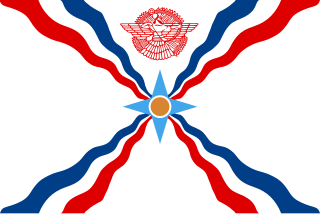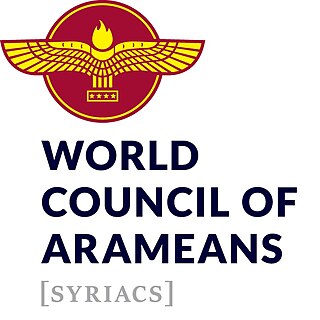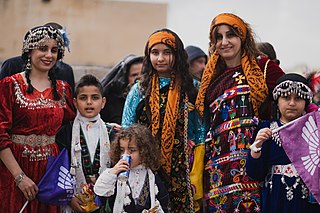Aramaic is a Northwest Semitic language that originated in the ancient region of Syria and quickly spread to Mesopotamia, the southern Levant, southeastern Anatolia, Eastern Arabia and the Sinai Peninsula, where it has been continually written and spoken in different varieties for over three thousand years.

Assyrians are an indigenous ethnic group native to Mesopotamia, a geographical region in West Asia. Modern Assyrians descend directly from Ancient Mesopotamians such as ancient Assyrians and Babylonians. Modern Assyrians may culturally self-identify as Syriacs, Chaldeans, or Arameans for religious, geographic, and tribal identification.
The Arameans, or Aramaeans, were an ancient Semitic-speaking people in the Near East that was first recorded in historical sources from the late 12th century BC. The Aramean homeland, sometimes known as the land of Aram, encompassed central regions of modern Syria.

Aram was a historical region mentioned in early cuneiforms and in the Bible, populated by Arameans. The area did not develop into a larger empire but consisted of a number of small states in present-day Syria. Some of the states are mentioned in the Old Testament, Damascus being the most outstanding one, which came to encompass most of Syria. Furthermore, Aram-Damascus is commonly referred to as simply Aram in the Old Testament.

The Assyrian flag is the flag widely used to represent the Assyrian nation in the homeland and in the diaspora.

Syriac Christianity is a branch of Eastern Christianity of which formative theological writings and traditional liturgies are expressed in the Classical Syriac language, a variation of the old Aramaic language. In a wider sense, the term can also refer to Aramaic Christianity in general, thus encompassing all Christian traditions that are based on liturgical uses of Aramaic language and its variations, both historical and modern.

Tell Halaf is an archaeological site in the Al Hasakah governorate of northeastern Syria, a few kilometers from the city of Ras al-Ayn near the Syria–Turkey border. The site, which dates to the sixth millennium BCE, was the first to be excavated from a Neolithic culture, later called the Halaf culture, characterized by glazed pottery painted with geometric and animal designs.

The Assyrian homeland, Assyria, refers to the homeland of the Assyrian people within which Assyrian civilisation developed, located in their indigenous Upper Mesopotamia. The territory that forms the Assyrian homeland is, similarly to the rest of Mesopotamia, currently divided between present-day Iraq, Turkey, Iran and Syria. In Iran, the Urmia Plain forms a thin margin of the ancestral Assyrian homeland in the north-west, and the only section of the Assyrian homeland beyond the Mesopotamian region. The majority of Assyrians in Iran currently reside in the capital city, Tehran.

Syrians are the majority inhabitants of Syria, indigenous to the Levant, who have Arabic, especially its Levantine dialect, as a mother tongue. The cultural and linguistic heritage of the Syrian people is a blend of both indigenous elements and the foreign cultures that have come to rule the land and its people over the course of thousands of years. By the seventh century, most of the inhabitants of the Levant spoke Aramaic. In the aftermath of the Muslim conquest of the Levant in 634, Arabic became the dominant language, but a minority of Syrians retained Aramaic, which is still spoken in its Syriac and Western dialects.
Assyrians/Syriacs in Sweden are citizens and residents of Sweden who are of Assyrian/Syriac descent. There are approximately 150,000 Assyrians/Syriacs in Sweden.

Terms for Syriac Christians are endonymic (native) and exonymic (foreign) terms, that are used as designations for Syriac Christians, as adherents of Syriac Christianity. In its widest scope, Syriac Christianity encompass all Christian denominations that follow East Syriac Rite or West Syriac Rite, and thus use Classical Syriac as their main liturgical language. Traditional divisions among Syriac Christians along denominational lines are reflected in the use of various theological and ecclesiological designations, both historical and modern. Specific terms such as: Jacobites, Saint Thomas Syrian Christians, Maronites, Melkites, Nasranis, and Nestorians have been used in reference to distinctive groups and branches of Eastern Christianity, including those of Syriac liturgical and linguistic traditions. Some of those terms are polysemic, and their uses have been a subject of terminological disputes between different communities, and also among scholars.

Assyrian nationalism is a movement of the Assyrian people that advocates for independence or autonomy within the regions they inhabit in northern Iraq, northeastern Syria, northwestern Iran, and southeastern Turkey.

King Kapara was an Aramean king of Bit Bahiani, one of the Post-Hittite states, centered in Guzana. He ruled sometime in the 10th or 9th century BCE, according to some estimations ca. 950-875 BCE. He built Bit-hilani, a monumental palace in Post-Hittite style, discovered by Max von Oppenheim in 1911, with a rich decoration of statues and relief orthostats.
The Hidden Pearl: The Syrian Orthodox Church And Its Ancient Aramaic Heritage is a 2001 documentary directed by Marcello Baldi. It was commissioned by the Syriac Orthodox Church and co-produced by Trans World Film Italia and Syriac Universal Alliance. The documentary was released as a three-episode miniseries together with three printed volumes.

The following outline is provided as an overview of and topical guide to Syria:

Syrianska Football Club, also known as Syrianska FC or simply Syrianska, is a Swedish professional football club based in Södertälje in Stockholm County. The club was founded by Syriac-Aramean immigrants in 1977 as Suryoyo Sportklubb, or Suryoyo SK. In 1986, its name was changed to Syrianska SK. The club adopted its present name as it grew and advanced through the league system. In 2010, after two years in Superettan, Syrianska was promoted to Allsvenskan for the first time in club history. This made Syrianska FC the 61st team to play in Allsvenskan. Since the Syriac people do not have an official national team, Syrianska is often seen as a substitute.

World Council of Arameans (Syriacs), previously known as the Syriac Universal Alliance (Syriac: ܚܘܝܕܐ ܣܘܪܝܝܐ ܬܒܝܠܝܐ, romanized: Ḥuyōdō Suryōyō Tbelōyō), is an international non-government umbrella organization, whose membership consists of several national associations, representing Arameans (also known as Syriac) from various countries around the world. Position of the SUA/WCA president is regarded as representative within Aramean/Syriac community. Since 2009, the organization is presided by Johny Messo.

Ethnic groups in the Middle East, in the 'transcontinental' region which is commonly a geopolitical term designating the intercontinental region comprising West Asia without the South Caucasus, and also comprising Egypt in North Africa. The region has historically been a crossroad of different cultures and languages. Since the 1960s, the changes in political and economic factors have significantly altered the ethnic composition of groups in the region. While some ethnic groups have been present in the region for millennia, others have arrived fairly recently through immigration. The largest socioethnic groups in the region are Arabs, Turks, Persians, Kurds, and Azerbaijanis but there are dozens of other ethnic groups that have hundreds of thousands, and sometimes millions of members.
The Assyrian Pentecostal Church, is a Reformed Eastern Christian denomination that began in ethnically Assyrian villages across the Urmia region in northwestern Iran, spreading to the Assyrians living in the adjacent cities, and from there to indigenous Assyrian communities in the Assyrian Homeland, northern Iraq, southeastern Turkey and northeastern Syria.

Assyrian continuity is the study of continuity between the modern Assyrian people, a Semitic indigenous ethnic, religious, and linguistic minority in the Middle East, and the people of Ancient Mesopotamia in general and ancient Assyria in particular. Assyrian continuity and Mesopotamian heritage is a key part of the identity of the modern Assyrian people. No archaeological, genetic, linguistic, anthropological, or written historical evidence exists of the original Assyrian and Mesopotamian population being exterminated, removed, bred out, or replaced in the aftermath of the fall of the Assyrian Empire, modern contemporary scholarship "almost unilaterally" supports Assyrian continuity, recognizing the modern Assyrians as the ethnic, linguistic, historical, and genetic descendants of the East Assyrian-speaking population of Bronze Age and Iron Age Assyria specifically, and Mesopotamia in general, which were composed of both the old native Assyrian population and of neighboring settlers in the Assyrian heartland.



















